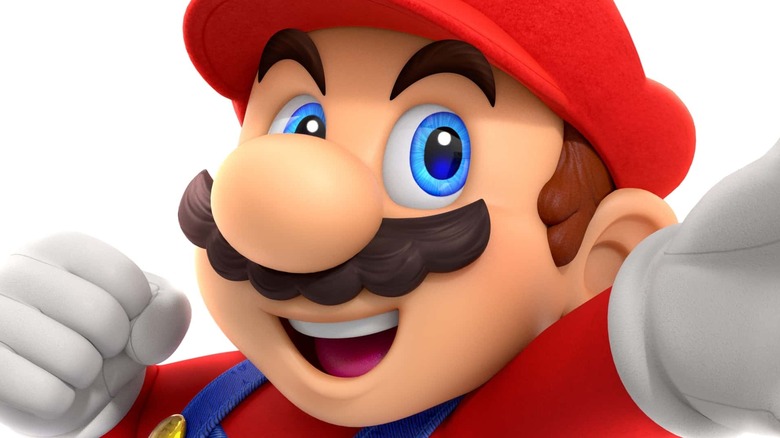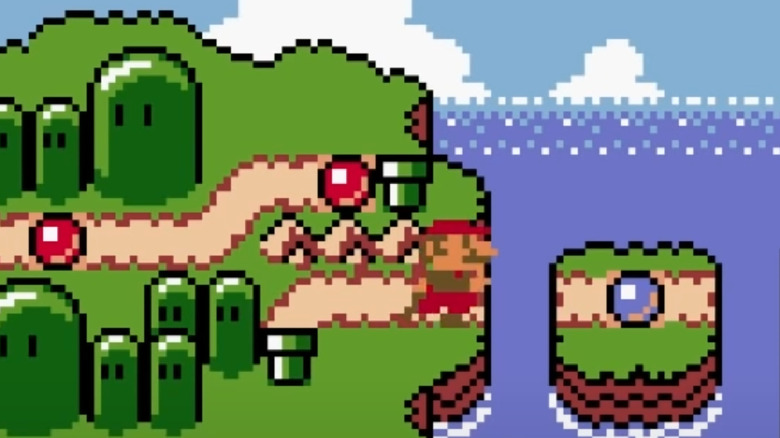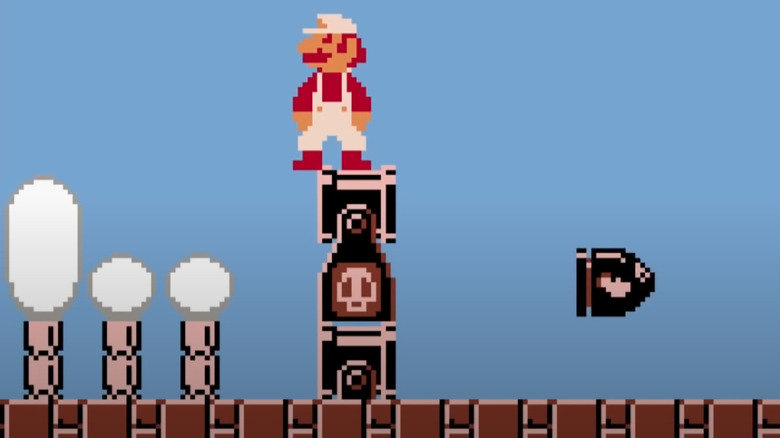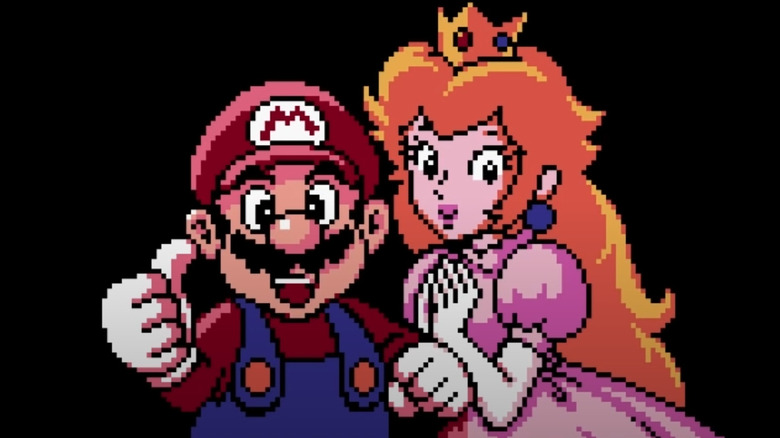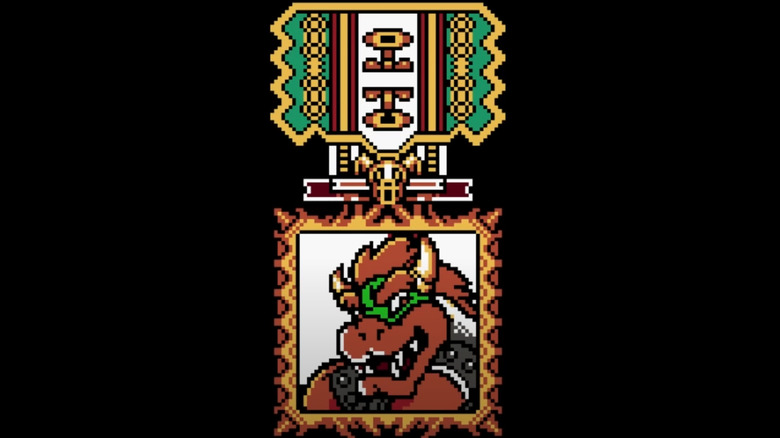The Big Differences Between Super Mario Bros. Deluxe And The Original Super Mario Bros.
Even 35-plus years since the original "Super Mario Bros." appeared on the NES, accessing the landmark title is still a walk in the park. Whether it's simply playing it through a Nintendo Switch Online subscription, purchasing the "Arcade Archives VS. Super Mario Bros." version on the eShop, or even just going through user-recreated levels from the game in "Super Mario Maker," there's no shortage of convenient methods to experience the game on modern devices. However, some might argue that the best version of "Super Mario Bros." actually debuted over 20 years ago — on a handheld without a backlight, no less.
The 1999 title "Super Mario Bros. Deluxe" shrunk down the original "Super Mario Bros." and tossed it onto the Game Boy Color, marking the first major handheld conversion of the title. As relatively seamless as that conversion was, however, this game wasn't content to simply recreate the 1985 classic and leave it at that. Instead, as its name suggests, "Super Mario Bros. Deluxe" is actually filled to the brim with tweaks, upgrades, and expansions that differentiate it from the original "Super Mario Bros." in several meaningful ways.
A world map and save slots
The original "Super Mario Bros." may be a classic that still holds up today, but it lacks a lot of the quality-of-life elements and visual dressing that modern "Mario" players might expect from the series nowadays. No world map strings levels together, with Mario progressing from one level to the next without much in the way of transitions. Even more egregious is the lack of a save system, meaning players must complete the game in a single sitting without turning the console off. The title is far from being the NES game that takes the longest to beat, but saving is a sorely-missed feature nonetheless.
"Super Mario Bros. Deluxe" changed all of this, retroactively fitting these mainstays of modern "Mario" games into the original experience. For one thing, it adds a "Super Mario World"-style map that allows players to chart their progress through each of the game's levels. More importantly, the enhanced port allows players to save between levels, meaning that they can start and stop a single playthrough across multiple sessions. This change especially befits the Game Boy Color's portable nature and undeniably makes "Super Mario Bros." a more accessible experience.
Crunched screen size and backtracking
The next big difference between "Super Mario Bros. Deluxe" and "Super Mario Bros." from the NES is a bit of a double-edged sword. Due to the tiny screen size of the Game Boy Color and its 10:9 aspect ratio, "Super Mario Bros. Deluxe" doesn't have the screen real estate necessary to display all the visual information at once that the original does. Unfortunately, that means the action is relatively zoomed in on Mario, and upcoming obstacles that would have been easy to see in the original version show up unexpectedly. Unfortunately, this concession results in some very frustrating "Mario" levels.
This change may sound like a pure downgrade, but "Super Mario Bros. Deluxe" adds another feature that helps mitigate this issue and even iterate on what the original game was capable of. Rather than only being able to move forward through a level, players can now slightly backtrack to the left — something that was utterly impossible in the original game. This lets players handily scroll the screen backward for a chance to go back and catch any power-ups, enemies, and anything else that might have inched off-screen.
A plethora of extra modes
The primary offering on display for "Super Mario Bros. Deluxe" may be the tidied-up version of the original "Super Mario Bros." campaign, but the classic trek through the Mushroom Kingdom isn't the only game experience crammed into the Game Boy Color port. In truth, the game is stuffed with additional modes, each of which either recontextualizes the levels from the main game or offers a different experience entirely.
In addition to the regular "Super Mario Bros." experience, referred to as "Original 1985," "Super Mario Bros. Deluxe" also features a "Challenge Mode." This allows players to choose any level from the original game and tasks them with locating hidden Red Coins and Yoshi Eggs to get the target high score. Speedrunners may also get a kick out of "You VS. Boo," where players race against computer-controlled Boos to clear a course as fast as possible. There's also a Toy Box section, where players can access various minigames, toys, and even a full-functioned calendar. Players can unlock the entirety of "Super Mario Bros.: The Lost Levels," adding a whole second game to the package. Value simply wasn't an issue here.
A built-in achievement system
Some Nintendo fans may still be begging the company to bring an achievement system to their platform in the vein of other console ecosystems like the PlayStation and Xbox, but "Super Mario Bros. Deluxe" already brought achievements to the original "Super Mario Bros." over 20 years ago. Indeed, just as a modern title like "Call of Duty: Modern Warfare 2" has achievements for accomplishing specific challenges, "Super Mario Bros. Deluxe" offers the same sort of system.
As players achieve certain milestones and records across the game's various modes, they'll be granted special awards and viewable pictures in the Album portion of the main menu. Achievements range from beating the primary campaign to defeating a certain number of Bowser bosses with fireballs to maxing out the total score meter in "Challenge Mode." A built-in achievement system lends yet another dose of replayability to the proceedings, giving "Super Mario Bros. Deluxe" a longevity that the original has a tough time rivaling.

